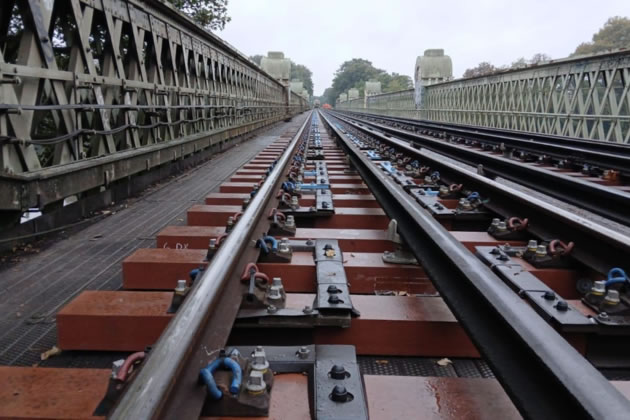Reduced Delays Promised After Kew Railway Bridge Track Upgrade
Work was carried out during series of weekend closures

The new tracks on Kew Railway Bridge. Picture: Network Rail
October 10, 2024
Network Rail is promising a more reliable service on London Overground and District line trains that use Kew Railway Bridge after the completion of recent works.
It has now completed track upgradeon the Grade II listed bridge over the River Thames between Kew Gardens and Gunnersbury stations and says further work is planned to reduce delays on a line which has been plagued by problems.
Over four weekends in September and October, engineers replaced all of the bridge’s 577 wheel timbers, which are used to hold the rails in place over the bridge on both lines. Engineers also replaced worn-out rail at either end of the structure.
The old wheel timbers were over 25 years old and in poor condition, which means they were more likely to cause track faults which lead to delays for passengers.
Network Rail says the replacement wheel timbers are made from a more durable material so they last longer and need less maintenance.
Kew railway bridge carries both London Overground’s Richmond – Stratford line and the District line. It is located on an intensively used stretch of the railway that has seen an increase in disruption in recent weeks.
Equipment that is causing multiple problems has been identified and a plan has been put into action to carry out repairs. Work is underway to improve both the management of the train service and the speed at which infrastructure problems are resolved.

Kew Railway Bridge is 155 years old. Picture: Network Rail
At the same time as the works on Kew railway bridge, Network Rail took the chance to cut back vegetation along the line. Engineers also replaced points at Gunnersbury and completed a range of track works at Richmond, including replacing points, rails, wooden timbers and track circuit equipment.
Simon Milburn, Network Rail Anglia infrastructure director, said, “Replacing the deteriorating wheel timbers on Kew railway bridge will help us to keep this wonderful heritage structure operating as a key part of these busy railway lines. This was a vital job that really needed doing, and I’d like to thank London Overground and District line passengers for bearing with us while we delivered the project.”
Like Reading Articles Like This? Help Us Produce More This site remains committed to providing local community news and public interest journalism. Articles such as the one above are integral to what we do. We aim to feature as much as possible on local societies, charities based in the area, fundraising efforts by residents, community-based initiatives and even helping people find missing pets. We've always done that and won't be changing, in fact we'd like to do more. However, the readership that these stories generates is often below that needed to cover the cost of producing them. Our financial resources are limited and the local media environment is intensely competitive so there is a constraint on what we can do. We are therefore asking our readers to consider offering financial support to these efforts. Any money given will help support community and public interest news and the expansion of our coverage in this area. A suggested monthly payment is £8 but we would be grateful for any amount for instance if you think this site offers the equivalent value of a subscription to a daily printed newspaper you may wish to consider £20 per month. If neither of these amounts is suitable for you then contact info@neighbournet.com and we can set up an alternative. All payments are made through a secure web site. One-off donations are also appreciated. Choose The Amount You Wish To Contribute. If you do support us in this way we'd be interested to hear what kind of articles you would like to see more of on the site – send your suggestions to the editor. For businesses we offer the chance to be a corporate sponsor of community content on the site. For £30 plus VAT per month you will be the designated sponsor of at least one article a month with your logo appearing if supplied. If there is a specific community group or initiative you'd like to support we can make sure your sponsorship is featured on related content for a one off payment of £50 plus VAT. All payments are made through a secure web site. |